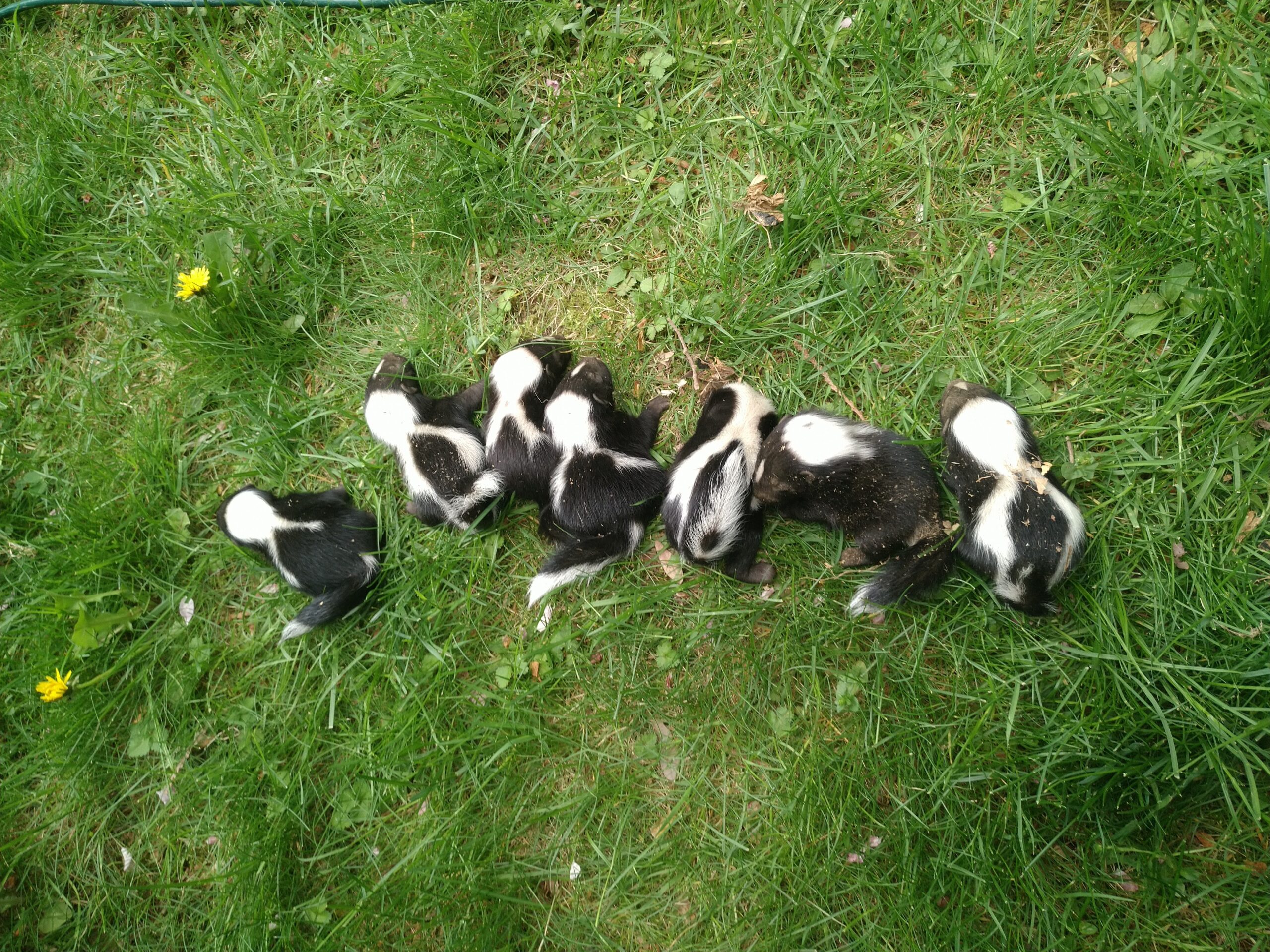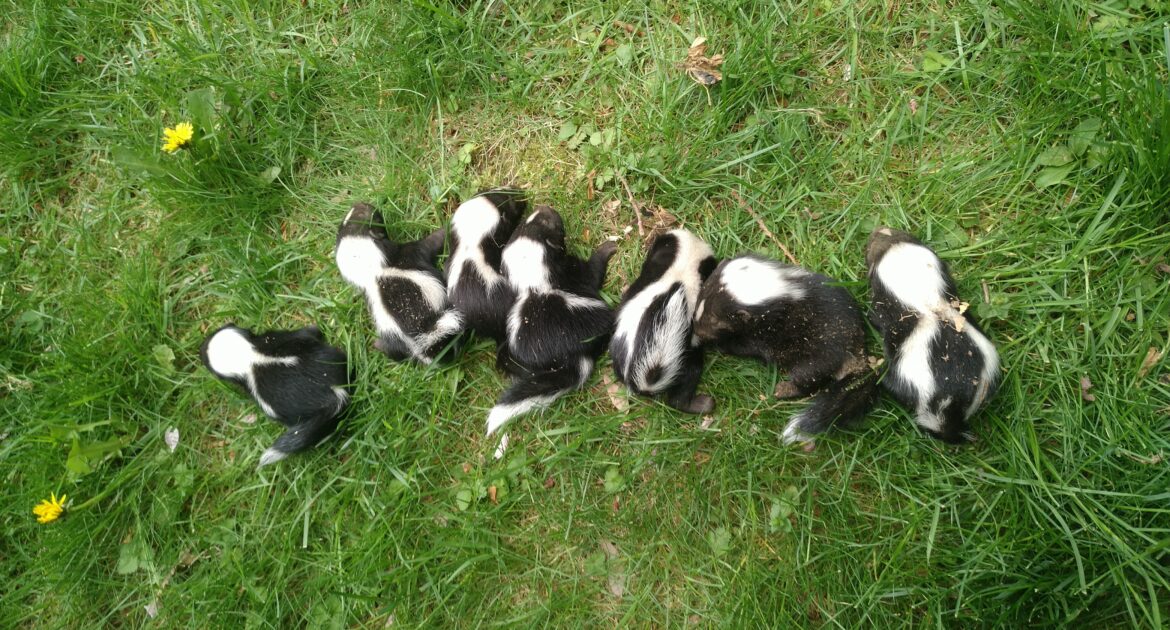Skunks are a common part of life in Minneapolis, whether you’re strolling through a park, walking near wooded areas, or in your own neighborhood. Most people are familiar with the striped skunk in Minneapolis, but did you know there are several other species that could make an appearance near your home? Each one has its own unique features and habits, making them both fascinating and, at times, a challenge to deal with.
From the striped skunk to the less common spotted skunk in Minnesota, these animals can bring some unwelcome surprises—like digging up your lawn or leaving behind droppings. If you’re wondering what kinds of skunks you might encounter and how to handle them safely, we’ve got you covered.
At Skedaddle Humane Wildlife Control in Minneapolis, we specialize in safe and effective wildlife removal services. This guide will walk you through the different skunk species you might see, how to recognize them, and the best ways to ensure they stay out of your property.
Striped Skunk (Mephitis mephitis) – The Most Common Skunk in Minneapolis
The striped skunk is the one you’re most likely picturing right now. They’re easy to recognize thanks to their signature look and unforgettable defense mechanism. Here’s what you should know about them:
Distinctive Features
- Appearance: Black fur with two wide white stripes running from head to tail.
- Size: About the size of a house cat, weighing 4 to 10 pounds.
- Defense Mechanism: Their infamous stinky spray can reach up to 10 feet when they feel threatened.
Behavior and Habitat
- Adaptability: Thrive in diverse environments, including open fields, wooded edges, and urban neighborhoods.
- Food Sources: Drawn to unsecured garbage bins, outdoor pet food, and compost piles.
- Signs of a Striped Skunk Nearby:
- Overturned trash cans.
- Persistent, foul odor.
Potential Problems with Skunks
- Damage to Property: Digging in lawns and gardens while hunting for grubs and insects.
- Health Hazards: Droppings left behind can carry disease or parasites.
- Odor Issues: Their spray is difficult to remove and can linger for days.
How To Minimize Skunk Activity
- Keep garbage bins securely sealed.
- Store pet food indoors.
- Manage compost piles to make them less attractive to skunks.
Although they’re common, striped skunks can bring their fair share of challenges. Taking steps to prevent their presence will help protect your property and avoid the stink they’re known for!
Spotted Skunk (Spilogale putorius) – A Rarer Sight in Minnesota
The spotted skunk is smaller and less common than its striped cousin, but it’s no less fascinating. This skunk doesn’t have neat stripes. Instead, it’s covered in broken white spots and stripes across a black coat. You might only catch glimpses of them since they weigh around 2 pounds, making them one of the smallest skunk species.
Spotted skunks are known for their acrobatics. When they feel threatened, they’ll stand on their front paws and perform a handstand before spraying. It’s an incredible sight, though one you probably don’t want to see up close for obvious reasons.
These skunks are most likely to be found in rural or semi-rural areas, such as farms, brushy vegetation, or alongside riverbanks. If you live near one of these areas in Minneapolis, a spotted skunk might wander onto your property. Like other skunks, they’re attracted to food scraps, so keeping your compost and garbage secure is key. Their droppings can also pose problems if left untreated, so any sign of these little visitors is worth addressing quickly.
Hog-Nosed Skunk (Conepatus leuconotus) – Uncommon but Possible Visitor
The hog-nosed skunk is a rare sight in Minnesota, but it’s not impossible to encounter one. These skunks are distinct because of their long snout and completely white backs. They’re also larger than other skunk species, weighing up to 10 pounds. Their size and appearance make them easy to identify if you happen to spot one.
These animals are expert diggers, thanks to their strong forelegs and long claws. They primarily dig through the soil, looking for grubs, insects, and worms, which are their favorite snacks. Unlike the striped skunk, hog-nosed skunks prefer rocky terrain and forested edges, but they’ll occasionally venture closer to homes if they smell food.
If you notice holes in your yard or garden, this skunk might be the culprit. They’re less common in residential neighborhoods, but that doesn’t mean they won’t show up. To prevent a hog-nosed skunk from sticking around, make sure to cover potential food sources and block access to spaces where they might den.
Eastern Hooded Skunk (Mephitis macroura) – A Rare Encounter
The eastern hooded skunk is possibly the rarest type to encounter in Minneapolis. These skunks are more common in warmer climates, but every so often, they can be found in southern parts of the state. They’ve got long, flowing fur, and a white “hood” covers much of their head and shoulders, giving them their name.
Despite their looks, they’re very similar to the striped skunk in behavior. They are shy and avoid contact with humans whenever possible. Like others, though, they’ll use their spray as a last line of defense. Their particular spray is known for being especially strong, so it’s best not to scare one by accident.
Hooded skunks prefer quiet, secluded places, but as with any wildlife, they may wander closer to homes if food sources, like trash or pet food, are available. While they’re rare, it’s still smart to know how to keep them out of your yard just in case.
How to Humanely Remove Skunks from Your Property
If you’re worried about having a skunk around your home, don’t panic. There are humane steps you can take to discourage them or safely remove them if they’ve already made themselves at home. Here’s what we recommend:
- Secure Garbage Bins: Skunks are scavengers, so unsecured trash bins are an open invitation. Use bins with tight-fitting lids to prevent them from getting in.
- Eliminate Food Sources: Avoid leaving pet food or food scraps outdoors. Even compost piles, if not properly managed, can attract skunks.
- Seal Entry Points: Skunks may use crawl spaces, sheds, or areas under decks for shelter. Inspect your property for gaps and close them off with durable materials before a skunk claims the space.
- Use Motion-Activated Lights: Skunks prefer dark, quiet spaces. Installing motion-activated lights can make your yard less appealing to them.
- Install One-Way Doors: One-way doors are a great solution to evict skunks humanely. They allow the animal to exit but prevent it from coming back in. This method ensures skunks can leave on their own without harm.
Taking these steps will help you prevent potential skunk problems while ensuring these creatures remain unharmed. If the situation feels beyond your control, it’s always a good idea to call in the experts.
Trust Skedaddle for Safe Skunk Solutions
Whether it’s a striped skunk in Minneapolis or a spotted skunk in Minnesota, dealing with these animals on your property can be tricky—and risky. Attempting to handle skunk removal by yourself isn’t safe for you or the animal. That’s why our team at Skedaddle Humane Wildlife Control in Minneapolis is here to help. We use humane, exclusion-based methods to safely remove skunks and make sure they don’t return.
If you need reliable wildlife removal services, we’re just a call away. Contact us to request a quote or to learn more about how we can protect your home and family.




